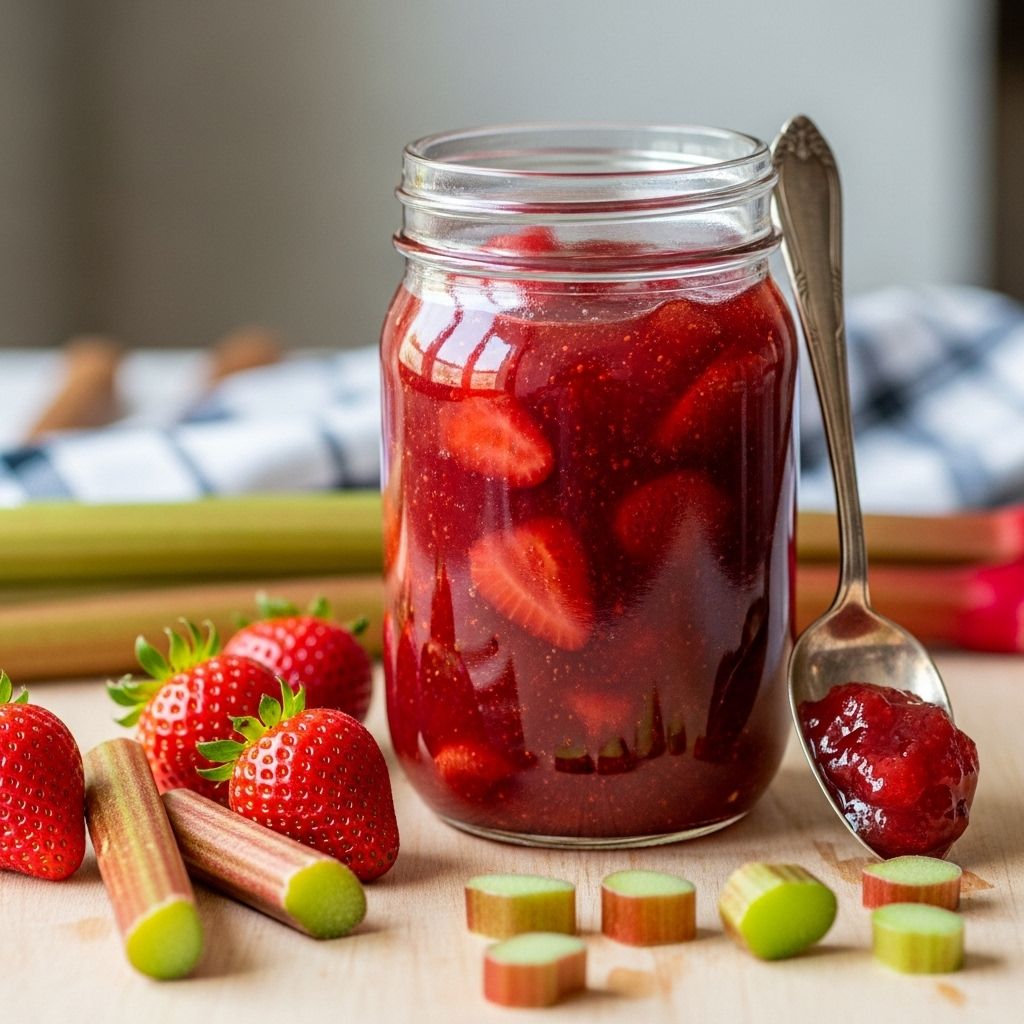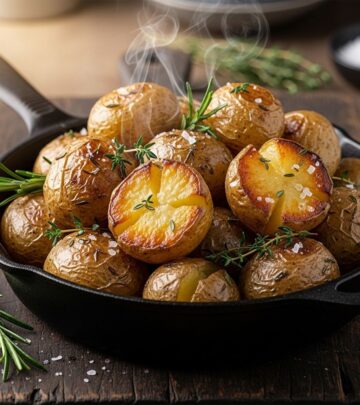Strawberry Rhubarb Jam Recipe: 5 Essential Tips For Perfect Jam
Learn how to make the perfect strawberry-rhubarb jam, from ingredients to canning and storage tips—ideal for beginners and jam enthusiasts alike.

Image: HearthJunction Design Team
Homemade Strawberry-Rhubarb Jam: A Sweet and Tangy Delight
If you’re seeking a jam that beautifully balances sweet strawberries and tart rhubarb, look no further. Strawberry-rhubarb jam is a beloved classic, cherished for its vibrant flavor, easy preparation, and versatility at the breakfast table. Whether you’re a seasoned canner or a first-time preserver, making this jam at home is a rewarding and surprisingly simple endeavor. Follow this comprehensive guide for ingredient tips, step-by-step instructions, canning advice, serving suggestions, and all the insider information you need for scrumptious, homemade strawberry-rhubarb jam.
Ingredients for Strawberry-Rhubarb Jam
Quality ingredients are the backbone of outstanding jam. For this classic recipe, you’ll need:
- 4 1/4 cups diced rhubarb – Select stalks that are deep red on the outside and firm to the touch for the best color and flavor.
- 4 1/4 cups sliced fresh strawberries – Ripe, sweet strawberries yield the richest taste and natural sweetness.
- 2 tablespoons lemon juice – Freshly squeezed preferred, but bottled can be used in a pinch. Lemon juice provides acidity for flavor balance and preservation.
- 2 (1.75 ounce) packages powdered fruit pectin – This helps the jam set properly, ensuring the perfect spreadable consistency.
- 7 cups white sugar – Essential for both sweetness and the preservation process; adjust to taste if your strawberries are especially tart or bland.
Step-by-Step Instructions
Follow these steps for jam-making success. Proper technique and timing ensure your jam has the right flavor, consistency, and color.
1. Preparing the Fruit
- Rhubarb: Wash the stalks thoroughly, trim off any leaves (which are inedible), and dice into small pieces. Discard any wilted or blemished stalks.
- Strawberries: Rinse under cold water, remove the stems, hull, and slice or chop as desired.
2. Cooking the Fruit Mixture
- In a large, heavy-bottomed pot, combine diced rhubarb, sliced strawberries, and lemon juice.
- Gradually stir in the powdered fruit pectin until fully dissolved.
- Place the pot over medium-high heat, stirring frequently, and bring the mixture to a full rolling boil (one that doesn’t subside when stirred).
3. Adding Sugar and Final Boil
- Once the fruit mixture is boiling, add the sugar all at once.
- Stir constantly to dissolve and incorporate the sugar fully.
- Return the mixture to a full rolling boil, stirring steadily to prevent scorching. Boil hard for exactly one minute.
- Remove from heat and skim off any foam with a spoon for a clearer jam.
4. Testing for Proper Set
- Optional: Place a small plate in the freezer beforehand. Drop a teaspoon of hot jam onto the cold plate—if it wrinkles when nudged after a minute, it’s set.
5. Filling the Jars
- Sterilize glass canning jars and their lids by boiling for 10 minutes or running through a hot dishwasher cycle.
- Ladle the hot jam into hot, sterilized jars, leaving about 1/4 inch headspace at the top.
- Wipe rims with a clean, damp cloth to remove any residue for a proper seal.
- Add lids and screw on bands just until fingertip tight.
Canning and Storage
For a shelf-stable jam, process the filled jars using the water bath canning method.
- Submerge jars in a boiling water canner, ensuring at least 1 inch of water covers the tops.
- Process jars in boiling water for 10 minutes (adjusting for altitude as needed).
- Carefully remove jars and let cool on a towel; lids should “pop” to indicate a proper seal.
- Once sealed, store jars in a cool, dark place. Refrigerate after opening and use within a few weeks.
Tips for Perfect Strawberry-Rhubarb Jam
- Choose peak-season fruit: The flavor and color of your jam depend greatly on the quality of your strawberries and rhubarb. Fresh, ripe fruit is best.
- Balance sweetness: If your berries are very tart, you might need a touch more sugar. Taste your fruit beforehand to determine how much to add.
- Don’t overcook: Extended boiling can dull flavors and colors. Watch the timing closely for best results.
- Use fresh lemon juice: Not only does it brighten flavors, but it also helps the jam set by increasing acidity.
- Skim the foam: For clear, beautiful jam, always skim off any foam before jarring.
Serving Suggestions
Strawberry-rhubarb jam is more than just a topping for toast! Try these creative ideas:
- Spread on warm, buttered bread or fresh-baked scones.
- Swirl into oatmeal, yogurt, or cottage cheese.
- Layer between cake layers or dollop over cheesecake for a fruity finish.
- Add a spoonful to ice cream for a summery sundae.
- Use as a glaze for grilled chicken or pork for a sweet-tart kick.
Storing and Preserving Your Jam
Proper storage ensures the safety and freshness of your homemade jam:
- Sealed jars: Store in a dark, cool pantry for up to one year.
- Opened jars: Keep refrigerated and use within 2–3 weeks.
- If you don’t wish to can, store the jam in the fridge and use within 10 days, or freeze for longer life.
Frequently Asked Questions (FAQs)
Q: Can I make strawberry-rhubarb jam without pectin?
A: Yes! Some recipes rely on the natural pectin in fruit and longer cooking times to set the jam. This may result in a looser consistency but plenty of fresh flavor.
Q: Can I reduce the amount of sugar?
A: You can reduce sugar, but it will affect the set, shelf life, and preservation. Low-sugar pectin or recipes specifically designed for less sugar are best if you want to cut back.
Q: How do I know if my jars have sealed properly?
A: After cooling, the lids should not flex up and down when pressed in the center. A proper seal “pops” when cooling and remains indented.
Q: Can I freeze this jam instead of canning?
A: Absolutely! Place cooled jam in freezer-safe containers, leaving room for expansion. Freeze for up to 6 months. Thaw in the refrigerator before use.
Q: Is it safe to double or halve the recipe?
A: For best results, avoid doubling. Large batches may not set properly. Halving is generally safe and preserves taste and texture.
Nutrition Information (approximate, per tablespoon)
| Nutrient | Amount |
|---|---|
| Calories | 50 |
| Total Fat | 0g |
| Carbohydrates | 13g |
| Sugars | 12g |
| Protein | 0g |
| Fiber | 0.2g |
Homemade Jam Success: Troubleshooting Tips
- Jam too runny? Simmer again with extra pectin or cook longer to help it set.
- Jam too thick? Stir in a splash of water or fruit juice to loosen it up.
- Foamy top? Skim foam before jarring to improve clarity and texture.
- Jars not sealing? Reprocess with new lids, or refrigerate and use first.
Creative Variations
- Add a teaspoon of vanilla or a pinch of cinnamon for depth of flavor.
- Mix in a handful of raspberries or blackberries with the strawberries and rhubarb for a mixed berry jam.
- For a savory twist, infuse your jam with a bit of fresh basil or mint during cooking, then remove before jarring.
Conclusion
Homemade strawberry-rhubarb jam is a celebration of summer’s bounty and kitchen art. This jam delivers bright, tangy, and sweet notes perfect for morning toast, dessert toppings, or gifting to friends and family. With proper technique, quality ingredients, and creative twists, your kitchen can become a jam-maker’s haven. Enjoy the process, savor the aroma, and relish the taste of your handmade creation all year long!
References
- https://www.allrecipes.com/recipe/214106/strawberry-rhubarb-jam/
- https://www.allrecipes.com/recipe/35545/rhubarb-strawberry-jam/
- https://www.allrecipes.com/recipe/222688/pectin-free-strawberry-rhubarb-jam/
- https://www.allrecipes.com/recipe/285968/strawberry-rhubarb-jam-with-basil/
- https://selfproclaimedfoodie.com/how-to-make-strawberry-rhubarb-jam/
Read full bio of Shinta












